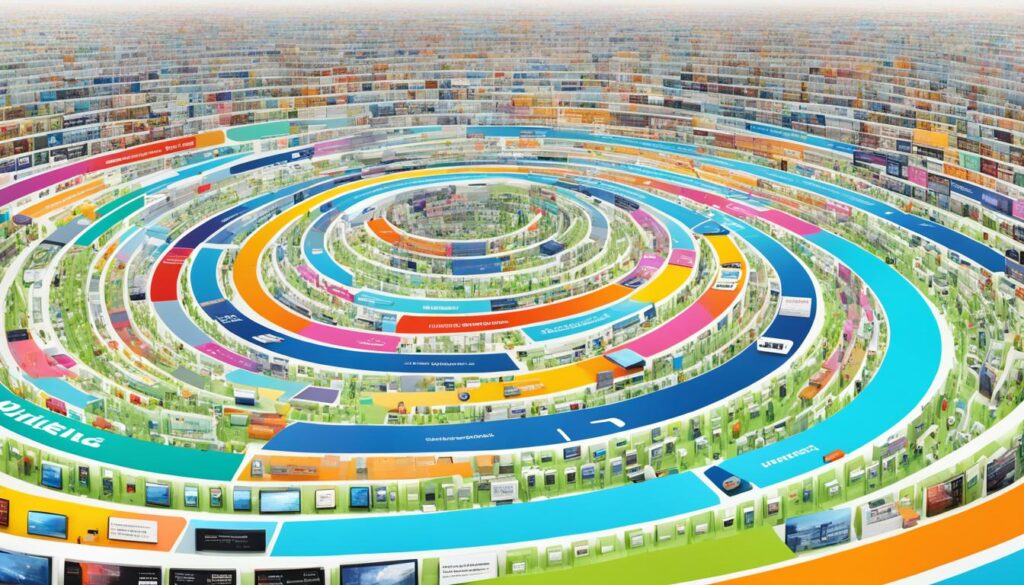Are you looking for ways to maximize your advertising reach and ROI? Want to know how multi-media advertising can help you achieve your campaign goals? In this article, we will delve into the benefits of multi-media advertising trends and why they are crucial in today’s digital landscape.
Multi-media advertising involves utilizing various channels and platforms, such as digital advertising, online marketing, social media advertising, and search engine optimization, to deliver your message to a wide audience. By leveraging content creation, graphic design, and video production, you can create compelling ad campaigns that capture the attention of your target market.
So, you might be wondering, how can multi-media advertising benefit your business? How does it help you exceed your campaign goals and reach a larger audience? And what opportunities does it offer for retargeting?
Join us as we explore the advantages of multi-media advertising and uncover the strategies to run successful multi-channel marketing campaigns. Discover how multimedia integration in eLearning can enhance engagement and retention. Plus, learn about the future media concepts driving the job market and the trends shaping the future of digital media.
Key Takeaways:
- Incorporating multi-media advertising can maximize your reach and return on investment (ROI).
- Multi-channel campaigns help you exceed campaign goals, cover the entire marketing funnel, and provide opportunities for retargeting.
- Utilizing multimedia in eLearning improves engagement, understanding, and retention.
- The strategic integration of multimedia requires careful planning and consideration of learner interaction and accessibility.
- The future of digital media presents exciting opportunities for communication professionals, but adaptation to emerging trends is key.
The Rise of Multi-Channel Advertising
In today’s programmatic landscape, multi-channel advertising has emerged as a crucial strategy for reaching consumers who are active across various channels and devices. With the increasing fragmentation of media consumption, it is essential for advertisers to adopt a multi-channel approach to effectively engage their target audience.
A research report revealed that implementing a multi-channel advertising strategy can lead to a better return on investment (ROI). In fact, 50% of advertisers who adopted this approach saw improved ROI. This underscores the importance of incorporating multiple channels into advertising campaigns.
As a result, advertisers are recognizing the significance of programmatic ad spend in driving successful multi-channel campaigns. According to industry insights, 40% of advertisers are planning to increase their programmatic ad spend in the next 12 months, highlighting the growing trend of leveraging programmatic capabilities for multi-channel advertising.
When it comes to executing multi-channel campaigns, agencies employ a range of channels and formats. Digital videos, display advertisements, and social media platforms are widely utilized to ensure comprehensive reach and engagement with the target audience.
Benefits of Multi-Channel Advertising:
- Expanded reach by targeting users across different platforms
- Improved return on investment (ROI)
- Increased exposure and awareness for brands
- Consolidated reporting for seamless analysis and tracking
- Opportunities for retargeting to drive conversions
Integrating multi-channel advertising strategies can significantly enhance marketing outcomes and ensure a competitive edge in today’s complex advertising landscape. The combination of diverse channels, consumer activity, and programmatic ad spend sets the stage for businesses to achieve their marketing goals effectively and efficiently.

5 Reasons to Use Multi-Channel Advertising
There are several advantages of using multi-channel advertising:
- Multi-Channel Advertising Helps You Exceed Campaign Goals: By optimizing targeting and reaching more of your target audience on the channels they spend the most time with, multi-channel campaigns can achieve or exceed key performance indicators (KPIs).
- Multi-Channel Campaigns Cover the Entire Funnel: A multi-channel strategy allows you to create multiple points of contact with your target audience, supporting upper- and lower-funnel goals, and guiding users from awareness through to conversion.
- Multi-Channel Advertising Delivers Increased Awareness: By consistently reminding users about your offerings across various channels, multi-channel campaigns help build brand awareness and inch users closer to conversion.
- Multi-Channel Campaigns Have Consolidated Reporting: Consolidated reporting within a single platform makes it easier to measure goals across different channels and ensures consistent and clear data.
- Provides Opportunities for Retargeting: Retargeting strategies allow for delivering online ads to users based on their previous intent-based actions, helping move users down the funnel towards conversion.

What are Multi-Channel Ads?
Multi-channel ads are campaigns that run across multiple platforms and channels, including programmatic channels, digital videos, in-game advertising, and connected TV. These versatile campaigns enable advertisers to reach users through various channels, ensuring maximum visibility and engagement.
By leveraging multi-channel ads, brands can tap into a wide range of platforms, such as social media, websites, mobile apps, and streaming services, to connect with their target audience.
Programmatic channels are an essential component of multi-channel advertising, allowing advertisers to automate the buying and selling of ad inventory in real-time. Through programmatic channels, brands can efficiently reach their target audience by leveraging audience data and targeting capabilities.
Digital videos are another crucial element of multi-channel ads, as they offer a highly engaging and immersive storytelling format. With the increasing popularity of video consumption, digital videos present a powerful tool for brands to captivate and communicate their message effectively.
In-game advertising is a growing trend in multi-channel ads, enabling brands to reach gamers across various gaming platforms. By integrating ads seamlessly into gameplay, in-game advertising offers a unique way to engage with a highly receptive audience.
Connected TV, including internet-enabled smart TVs and streaming devices, has gained significant traction in recent years. Multi-channel ads can be delivered through these connected TVs, allowing brands to target viewers who are increasingly consuming content through over-the-top (OTT) platforms.
In summary, multi-channel ads provide advertisers with a comprehensive approach to reach their target audience across diverse platforms and channels. By harnessing the power of programmatic channels, digital videos, in-game advertising, and connected TV, brands can create cohesive and impactful campaigns that resonate with their audience.
How to Run a Multi-Channel Marketing Campaign?
To run a successful multi-channel marketing campaign, it is essential to utilize a programmatic platform. A programmatic platform simplifies the distribution of campaigns across various channels, ensuring effective targeting of users across devices.
One of the key advantages of programmatic platforms is the ability to achieve cross-device targeting, enabling you to reach your target audience on desktops, mobiles, tablets, and connected TVs. This ensures that your campaign message is delivered to users regardless of the device they are using, maximizing your reach and engagement.
With the help of cross-device targeting, you can create a cohesive brand experience across different devices, ensuring that your message is consistent and impactful. This level of precision targeting allows for a more personalized advertising experience, increasing the chances of capturing your audience’s attention and driving them towards conversion.
By leveraging a programmatic platform and implementing cross-device targeting, you can optimize your multi-channel marketing campaign for success. This strategic approach ensures that your campaign reaches users on the platforms and devices they prefer, maximizing the effectiveness of your marketing efforts and driving meaningful results.
Take advantage of the opportunities offered by a multi-channel marketing campaign and start reaching your target audience across various channels and devices today.
The Importance of Multimedia in eLearning
When it comes to eLearning, multimedia plays a crucial role in enhancing the learning experience. By integrating various content formats such as text, images, audio, and video, multimedia creates a cohesive and engaging environment for learners. This approach caters to the diverse learning styles of individuals, including visual, auditory, and kinesthetic learners.
With multimedia, educational content becomes more interactive and dynamic, capturing the attention of learners and promoting better understanding and retention of knowledge. Visual learners can benefit from vibrant images and diagrams, while auditory learners can engage with audio lectures and discussions. Kinesthetic learners can participate in interactive activities and simulations, promoting hands-on learning.
One of the key advantages of multimedia in eLearning is its ability to enhance learner engagement. By incorporating different media elements, eLearning courses become more interactive and stimulating for learners, keeping them actively involved in the learning process. This engagement fosters a deeper understanding of the content and facilitates the application of knowledge in real-world scenarios.
Moreover, multimedia in eLearning supports the retention of information. By presenting content in various formats, learners are exposed to different channels of information, improving their chances of remembering key concepts. For instance, a combination of visuals, audio cues, and textual explanations can reinforce the learning experience and ensure long-term retention.
Addressing Different Learning Styles
Every learner has unique preferences and learning styles. Some individuals prefer visual aids, while others benefit more from auditory cues or reading/writing activities. Multimedia in eLearning addresses these diverse learning needs by incorporating various media formats that cater to different learning preferences.
Visual learners, for example, can benefit from infographics, diagrams, and videos that provide a visual representation of the subject matter. Auditory learners can engage with audio lectures, podcasts, or interviews that stimulate their auditory senses. Reading/writing learners can take advantage of interactive text-based activities and quizzes that allow them to process information through reading and writing.
By encompassing different media elements, multimedia in eLearning ensures that learners can engage with the content in a way that aligns with their preferred learning style, leading to a more personalized and effective learning experience.
In summary, multimedia is an essential component of eLearning that supports learner engagement, understanding, retention, and the application of knowledge. By leveraging the power of various content formats, eLearning courses can create an interactive and immersive learning environment that caters to diverse learning styles.
Advantages of Leveraging Multimedia for Learning
In today’s digital age, incorporating multimedia elements into the learning process has become increasingly beneficial. By leveraging multimedia, educators can enhance learning engagement, facilitate the understanding of complex concepts, cater to diverse learning needs, promote practical application of knowledge, and improve memory retention.
One of the key advantages of multimedia in learning is its ability to boost learner engagement. By incorporating interactive elements such as videos, animations, and quizzes, educators can make the learning experience more dynamic and captivating. This interactivity helps hold learners’ attention and encourages active participation, resulting in better knowledge absorption and retention.
Complex learning requires a multi-dimensional approach, and multimedia provides the perfect platform for presenting intricate concepts. Through visual representations, audio explanations, and interactive simulations, learners can grasp complex ideas and processes more easily. The combination of different media formats helps cater to diverse learning needs, ensuring that learners with different learning styles can comprehend and apply the acquired knowledge effectively.
Furthermore, multimedia in learning encourages practical application of knowledge. By incorporating real-life examples, case studies, and simulations, educators enable learners to understand how concepts and theories are employed in real-world scenarios. This practical application helps learners develop critical thinking and problem-solving skills, making them better prepared for professional challenges.
Lastly, multimedia aids in memory retention. Research has shown that images, videos, and interactive elements have a stronger impact on memory compared to text alone. By presenting information in various formats, multimedia stimulates multiple senses, making learning more memorable. This enhanced memory retention allows learners to recall information more effectively when needed.
In conclusion, leveraging multimedia in learning offers numerous advantages. By harnessing the power of multimedia elements, educators can create engaging learning experiences, facilitate understanding of complex concepts, cater to diverse learning needs, promote practical application of knowledge, and enhance memory retention. The integration of multimedia resources into the curriculum not only supports effective learning outcomes but also prepares learners for success in their personal and professional lives.
Strategic Integration of Multimedia in Learning
When it comes to effective learning, the strategic integration of multimedia plays a crucial role. Incorporating various multimedia elements into educational content can enhance engagement, understanding, and the application of knowledge. To ensure the successful integration, specific strategies should be considered.
Integrating Multimedia Elements Purposefully
When integrating multimedia into learning materials, it is important to do so purposefully. Each multimedia element should serve a specific learning objective and contribute to the overall educational experience. By aligning the multimedia elements with the desired learning outcomes, learners can more effectively grasp and retain information.
Optimizing for Engagement
An essential aspect of multimedia integration is optimizing for learner engagement. Engaging learners through a combination of visual, auditory, and interactive elements can increase their interest, motivation, and active participation. This can be achieved by incorporating compelling visuals, interactive exercises, and multimedia presentations that capture learners’ attention and maintain their focus.
Applying Storytelling Techniques
Storytelling techniques can be a powerful tool in effectively conveying educational content. By creating narratives or scenarios that relate to real-life situations, learners can better understand and connect with the subject matter. Incorporating multimedia elements, such as videos or interactive simulations, can further enhance the storytelling experience and facilitate knowledge absorption.
Ensuring Technological Accessibility
Technological accessibility is essential for effective multimedia integration in learning. Ensuring that learners have the necessary devices, software, and internet access to interact with multimedia elements is crucial. Additionally, optimizing multimedia content for different devices and platforms, such as desktop computers, mobile devices, and tablets, can enhance accessibility and reach a wider audience.
Prioritizing Learner Interaction
The integration of multimedia should encourage active learner interaction. Providing opportunities for learners to explore, manipulate, and engage with multimedia elements fosters a deeper understanding and retention of the content. This can be achieved through interactive quizzes, simulations, or collaborative activities that promote hands-on learning.
Exploring Real-World Examples
Real-world examples of successful multimedia integration in learning can inspire educators and instructional designers. Platforms like Khan Academy, Google Earth Education, and TED-Ed showcase innovative approaches to integrating multimedia elements and engaging learners. By studying these examples, educators can gain insights into effective strategies and adapt them to their own instructional practices.
The strategic integration of multimedia elements in learning can significantly enhance the educational experience, promote engagement, and facilitate effective knowledge transfer. By purposefully integrating multimedia, optimizing for engagement, applying storytelling techniques, ensuring technological accessibility, prioritizing learner interaction, and exploring real-world examples, educators can create compelling and impactful learning environments.
Learn more about the benefits and strategies of integrating multimedia in learning.
Expanding on Real-World Examples
Real-world examples of multimedia integration in learning include Khan Academy, Google Earth Education, and TED-Ed. These platforms have revolutionized the way education is delivered and accessed.
Khan Academy, a renowned online education platform, offers a wide range of free educational resources spanning various subjects and grade levels. It utilizes multimedia elements such as videos, interactive exercises, and quizzes to engage learners and enhance their understanding.
Google Earth Education is another powerful tool that brings interactive maps and virtual exploration into the classroom. It allows students to visualize geographical and historical concepts, fostering a deeper understanding and appreciation for the world around them.
TED-Ed, a platform affiliated with the popular TED Talks, provides educational videos that cover a wide range of subjects. These engaging videos incorporate animated visuals, engaging storytelling, and expert knowledge, making complex topics more accessible and engaging for learners of all ages.
When integrating multimedia into eLearning, there are additional tips to consider:
- Leverage user-generated content to encourage active participation and collaboration among learners.
- Utilize feedback loops to gather insights and make continuous improvements to the learning experience.
- Incorporate gamification elements, such as badges or leaderboards, to create a sense of achievement and motivation.
- Provide support materials, such as study guides or supplementary readings, to enhance understanding and reinforce key concepts.
- Stay current with technology trends and explore new tools and platforms that support collaborative learning and multimedia integration.
- Balance multimedia elements to ensure a cohesive and engaging learning experience without overwhelming learners.
- Adapt to feedback from learners and make adjustments to the multimedia content and delivery to meet their evolving needs.
- Incorporate microlearning techniques by breaking down complex topics into bite-sized modules for better comprehension and retention.
- Measure and analyze learner engagement and performance to assess the effectiveness of multimedia integration and make data-driven improvements.
Integrating multimedia in eLearning offers numerous benefits, from increased learner engagement to improved retention and application of knowledge. By leveraging real-world examples and implementing best practices, educators can create powerful learning experiences that resonate with learners and maximize their educational outcomes.
Future Media Concepts Driving the Job Market
In an era of digital advances, the future of media is poised for significant transformations that will impact communication professions. As technology continues to evolve, the need for skilled professionals in fields such as social media management, digital media management, content strategy, and communication specialization is on the rise.
The role of social media managers is becoming increasingly crucial as businesses recognize the power of social media platforms in reaching and engaging with their target audience. These professionals are adept at creating and executing communication strategies tailored to different digital platforms, driving brand awareness and customer engagement.
Digital media managers, on the other hand, are responsible for overseeing the overall digital presence of a company. They navigate the complex landscape of online advertising, search engine optimization, and content creation to ensure that the brand’s digital campaigns are effective and aligned with its objectives.
Content strategists play a vital role in shaping a brand’s messaging and ensuring its consistency across various digital channels. These professionals are skilled in crafting compelling content that resonates with the target audience, drives engagement, and supports the brand’s objectives.
Communication specialists, equipped with their deep understanding of digital media and communication trends, are the driving force behind successful communication strategies. They possess the expertise to analyze data, develop audience insights, and leverage digital tools to create meaningful connections between businesses and their target audience.
As the landscape of media continues to evolve, these communication professions will continue to play a crucial role in helping businesses adapt and thrive in the digital age. The future of media is bright, and professionals who embrace digital advances will have vast opportunities for growth and success.
Future of Digital Media Trends
The future of digital media is shaped by several key trends that are revolutionizing the way we consume media and how companies engage with their audience.
Online Consumption
One of the pivotal factors driving the future of digital media is the rise of online consumption. With the increasing availability of high-speed internet and the growing popularity of smartphones and other digital devices, people are spending more time online than ever before. This presents new opportunities for businesses to reach their target audience through various online channels.
Social Media Scrutiny
Social media platforms have become an integral part of our lives, and along with their popularity comes increased scrutiny. Users are becoming more conscious of the content they consume and the platforms they use. As a result, companies are under pressure to maintain transparency, authenticity, and ethical practices in their digital media strategies to build trust and credibility with their audience.
The Power of Influencers
Influencer marketing has emerged as a powerful tool for brands to connect with their target audience. Influencers, with their large and engaged followers, hold the power to shape consumer opinions and drive purchasing decisions. As the influence of social media continues to grow, partnering with influencers will remain a vital aspect of digital media strategies for brands looking to amplify their message and increase brand awareness.
Social Movements
Social movements have gained significant traction in the digital age, with campaigns centered around important social and environmental issues capturing the attention of millions. Activism and digital media go hand in hand, providing a platform for individuals and communities to voice their opinions, raise awareness, and drive meaningful change. Companies that align themselves with social movements can foster stronger connections with their audience and demonstrate their commitment to societal values.
The future of digital media is dynamic and ever-evolving, influenced by trends like online consumption, social media scrutiny, the power of influencers, and the rise of social movements. Embracing these trends and adapting to the changing digital landscape will be crucial for businesses aiming to effectively engage their audience and stay ahead in the digital age.
Conclusion
The future of digital media presents exciting opportunities for communication professionals. With the continuous evolution of technology and the emergence of new trends, it is essential for individuals in this field to adapt and embrace innovation to stay competitive in their careers.
Digital media has transformed the way we communicate, opening up various avenues for professionals to explore. From social media managers to digital media managers and content strategists, the job market is witnessing the rise of new job titles that cater to the changing landscape of communication.
Technology innovations are driving the future of digital media, offering unprecedented possibilities and transforming how companies connect with their audience. As communication professionals embrace these advancements, they can leverage the power of digital media to create compelling content, engage with audiences, and drive business results.
As the digital media landscape continues to evolve, communication professionals with the skills and knowledge to navigate through these changes will be well-positioned for future success. By staying updated with technology innovations and exploring new job titles, individuals can seize the abundant opportunities that lie ahead in the dynamic field of digital media.



